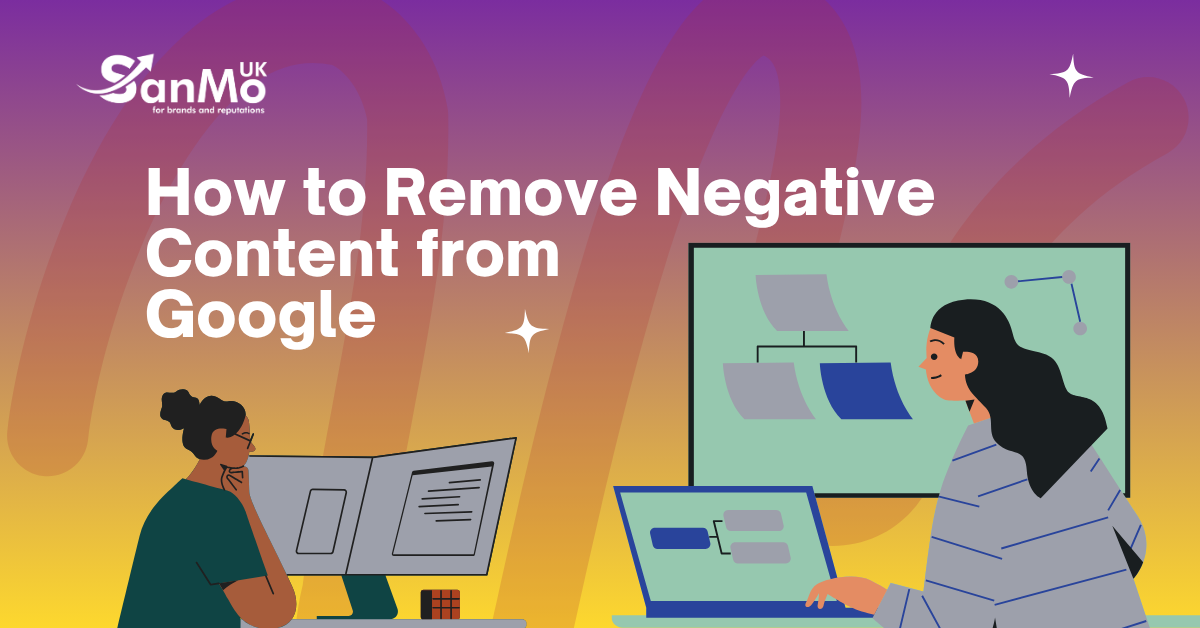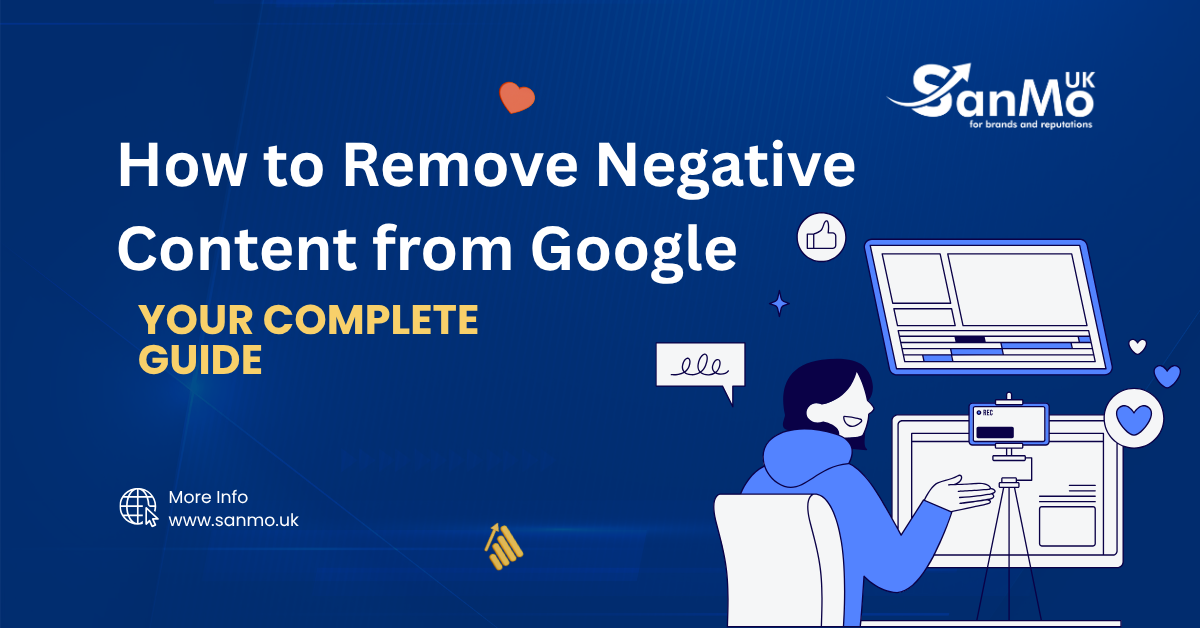A single negative article about a CEO surfaced on Google’s first page, causing the company’s stock price to drop by 12% within 48 hours. The article contained outdated information from a lawsuit that had been dismissed years earlier, but potential investors didn’t know that—they only saw the headline.
This scenario illustrates the massive impact negative content can have on businesses and individuals. Whether it’s an unfair review, outdated legal information, or a malicious blog post, harmful content in Google search results can derail careers, damage brand reputation, and cost thousands in lost revenue.
The digital landscape has fundamentally changed how we build and maintain trust. Your online reputation often forms someone’s first impression of you or your business. When negative content ranks high in search results, it can overshadow years of hard work and positive achievements.
At SanMo UK, we’ve helped countless clients navigate the complex world of digital reputation management. We understand that negative content removal isn’t just about cleaning up search results—it’s about protecting your future opportunities and restoring confidence in your brand.
In this post, we’ll explore how to remove negative content from Google effectively, covering everything from DIY removal techniques to professional suppression strategies that can restore your online reputation.
What Is Considered Negative Content?
Negative content encompasses any online material that portrays you or your business in an unfavorable light. This broad category includes several types of content that can damage your reputation:
Customer reviews and ratings from platforms like Google My Business, Yelp, Trustpilot, or industry-specific review sites often contain the most visible negative content. Even one harsh review can significantly impact a small business’s reputation.
Blog posts and news articles that mention you or your company in a negative context pose serious threats. These might include critical op-eds, investigative pieces, or even competitor-driven content designed to harm your reputation.
Social media mentions across platforms like Twitter, Facebook, LinkedIn, and Instagram can spread quickly and remain searchable for years. Negative tweets or posts can gain traction and appear prominently in search results.
Legal and public records, including court documents, bankruptcy filings, arrest records, and other legal proceedings often appear in Google searches. While some of this information is public record, outdated or irrelevant legal content can unfairly impact your reputation.
Forum discussions and comment sections on websites like Reddit, Quora, or industry forums can contain damaging conversations about your business or personal brand. These discussions often rank well in search results due to the platforms’ high domain authority.
Image-based content, such as unflattering photos, memes, or visual content that portrays you negatively, can appear in Google Images searches and impact your reputation.
The platforms where negative content appears are equally diverse. Google Search results obviously represent the primary concern, but content can also surface on specialized review sites, industry forums, social media platforms, news websites, and even personal blogs or competitor websites.
The effects of negative content extend far beyond hurt feelings. For businesses, negative content can reduce customer trust, decrease conversion rates, and harm search engine optimization efforts. Individuals may face lost job opportunities, damaged professional relationships, and personal distress from harmful online content.
Why Negative Content Matters in the Digital Age
Search visibility directly influences decision-making processes across all sectors. Research shows that 75% of people never scroll past the first page of Google search results, meaning that negative content ranking on page one can effectively define your online reputation.
First impressions increasingly happen through Google searches rather than face-to-face meetings. Potential employers, customers, partners, and even romantic interests often research you online before any personal interaction. When negative content dominates your search results, you’ve lost the opportunity to make a positive first impression.
The business impact of negative online content is substantial and measurable. Companies regularly lose contracts, partnerships, and customers based solely on what appears in search results. One study found that a single negative news article about a company can decrease its market value by up to 2% within days of publication.
For individuals, negative online content can derail career opportunities before they begin. Hiring managers routinely conduct online background checks, and negative search results can eliminate candidates from consideration regardless of their qualifications or the accuracy of the information found.
The speed at which negative content can spread compounds these problems. Social media sharing, news aggregation sites, and SEO-savvy publishers can ensure that negative content about you appears on multiple websites within hours, creating a web of harmful information that’s difficult to address comprehensively.
Can You Really Remove Negative Content from Google?
The short answer is: sometimes, depending on the source, content type, and legal circumstances surrounding the material. Understanding what can and cannot be removed helps set realistic expectations for your reputation management efforts.
Content that can often be removed includes:
Material that violates Google’s content policies, such as spam, copyright infringement, or deliberately misleading information. Google maintains specific guidelines about what content is acceptable, and violations can result in removal from search results.
Personal identifiable information that was published without consent, including Social Security numbers, bank account information, or private contact details. Google has specific policies protecting personal privacy information.
Non-consensual intimate images, often called revenge porn, which Google actively worked to remove from search results through its specialized reporting process.
Outdated mugshots and arrest records, particularly when charges were dropped or the person was found not guilty. Many jurisdictions now have laws requiring mugshot websites to remove these images upon request.
Defamatory content that meets specific legal criteria for libel or slander. However, proving defamation requires clear evidence that the content is both false and harmful.
Content that typically cannot be removed includes:
Legitimate news coverage, even if unfavorable, generally enjoys protection under freedom of the press principles. News articles from credible sources rarely qualify for removal unless they contain clear factual errors.
Truthful customer reviews, regardless of how harsh or unfair they may seem. Review platforms protect honest customer feedback, and Google generally doesn’t remove negative reviews that don’t violate platform guidelines.
Court records and legal documents are part of the public record. While frustrating, legally accessible public records usually remain available online.
Opinions and commentary that don’t make false statements of fact. The line between opinion and defamation can be complex, but genuine opinions typically receive protection.
Content on websites that don’t respond to removal requests. Many website owners ignore removal requests, particularly if the content drives traffic to their sites.
Step-by-Step: How to Remove Negative Content from Google

Successfully removing negative content requires a systematic approach that addresses both the source website and Google’s search index. Follow these steps to maximize your chances of removal:
Identify the Source and Type of Content
Begin by documenting all negative content that appears in your search results. Take screenshots of each piece of content, noting the URL, publication date, and platform where it appears. This documentation will prove valuable if you need to pursue legal action or work with a reputation management professional.
Categorize the content by type—reviews, news articles, social media posts, or forum discussions. Different content types require different removal strategies, and understanding what you’re dealing with helps prioritize your efforts.
Research the website or platform hosting the content. Look for contact information, content policies, and removal procedures. Some sites have specific processes for content removal requests that must be followed precisely.
Contact the Website Owner or Platform
Most successful content removals begin with direct communication to the website or platform hosting the negative material. Craft professional, factual removal requests that clearly explain why the content should be removed.
For review sites, focus on policy violations rather than arguing about the review’s fairness. Most platforms will only remove reviews that violate their terms of service, such as fake reviews, reviews that contain profanity, or reviews that reveal private information.
When contacting news websites or blogs, provide clear evidence if the content contains factual errors. Reputable publications often have editorial policies requiring corrections or removals when they publish inaccurate information.
For social media platforms, use their built-in reporting mechanisms. Each platform has specific processes for reporting harmful content, and following these procedures increases your chances of successful removal.
Request Content Removal
Your removal request should be professional, specific, and legally sound. Include the following elements:
Clear identification of the content you want removed, including specific URLs and publication dates.
Detailed explanation of why the content should be removed, referencing specific policy violations or legal grounds.
Supporting documentation, such as court records showing dismissed charges or evidence of factual errors in the content.
Professional tone that avoids emotional language or threats. Aggressive requests often receive negative responses from website owners.
Reasonable timeline for response, typically 7-14 business days for most platforms.
File a Request with Google
If direct removal from the source website isn’t possible, Google offers several removal tools for specific types of content. The Google Removal Tool allows you to request the removal of content that violates Google’s policies or contains personal information published without consent.
Google’s removal process focuses on specific categories:
Personal information removal for content containing Social Security numbers, bank account numbers, or other sensitive personal data.
Non-consensual intimate image removal through Google’s specialized reporting process.
Doxxing content removal for material that could facilitate harassment or violence.
Copyright infringement removal through DMCA takedown requests for content that violates your intellectual property rights.
Each removal category has specific requirements and documentation needs. Google typically processes removal requests within 24-48 hours for clear policy violations.
Suppress with Positive SEO and Content Strategies
When direct removal isn’t possible, suppression strategies can push negative content lower in search results by promoting positive content. This approach requires ongoing effort but can effectively minimize the impact of harmful content.
Create high-quality, positive content about yourself or your business across multiple platforms. This might include professional profiles on LinkedIn, personal websites, positive press releases, or guest blog posts on reputable sites.
Optimize existing positive content for search engines by ensuring proper keyword usage, meta descriptions, and internal linking. Professional SEO techniques can help positive content rank higher than negative material.
Build authoritative backlinks to positive content from reputable websites. Quality backlinks signal to Google that your positive content deserves higher rankings than negative material.
What If You Can’t Remove It? Suppression Strategies
When negative content cannot be removed from its source, suppression strategies offer an alternative path to reputation recovery. These techniques focus on promoting positive content to outrank harmful material in search results.
SEO-based reputation management forms the foundation of most suppression strategies. By creating and optimizing positive content across multiple platforms, you can gradually push negative content to lower search result positions where fewer people will see it.
Effective suppression requires understanding how Google ranks content. Factors like domain authority, content freshness, user engagement, and backlink quality all influence search rankings. Professional reputation management services leverage these factors to promote positive content strategically.
Content marketing and blog outreach provide sustainable ways to create a positive online presence. Regular blog posting, guest article contributions, and strategic content partnerships can generate multiple positive search results over time.
Focus on creating valuable, relevant content that naturally incorporates your name or business name. This might include industry insights, professional achievements, community involvement, or thought leadership pieces that showcase your expertise.
Building backlinks to positive content amplifies your suppression efforts by increasing the authority of favorable material. Quality backlinks from reputable websites signal to Google that your positive content deserves higher rankings.
Legitimate link-building strategies include professional networking, industry participation, speaking engagements, and collaborative content creation. Avoid paid link schemes or other tactics that violate Google’s guidelines, as these can backfire and harm your overall online presence.
Google My Business optimization particularly benefits local businesses dealing with negative reviews or local search issues. A well-optimized business profile with regular posts, positive customer interactions, and accurate information can dominate local search results.
Encourage satisfied customers to leave positive reviews, respond professionally to all feedback, and maintain active engagement through posts and updates. This ongoing activity signals to Google that your business profile deserves prominent placement in local search results.
SanMo UK’s negative content removal service UK combines these suppression strategies with direct removal efforts to provide comprehensive reputation management solutions. Our approach addresses both immediate removal opportunities and long-term reputation building to ensure sustainable results.
Using Negative Keywords in Content Marketing
Understanding the difference between negative content and negative keywords is crucial for comprehensive reputation management. While negative content refers to harmful material about you or your business, negative keywords serve as a strategic marketing tool to prevent your ads from appearing for irrelevant or harmful searches.
Negative keywords in PPC campaigns help marketers avoid spending money on clicks that won’t convert. For example, a luxury hotel might use “cheap” as a negative keyword to prevent its ads from appearing when someone searches for “cheap hotels.” This ensures their advertising budget targets appropriate audiences.
From a reputation management perspective, negative keywords become particularly important when running campaigns to promote positive content about your brand. You want to ensure your positive ads don’t appear alongside searches for harmful terms related to your business.
Best practices for avoiding harmful search associations include researching all possible search variations that might trigger your content or ads. Use keyword research tools to identify potentially problematic search terms and exclude them from your campaigns.
Consider both direct negative keywords (like “scam” or “complaint”) and indirect terms that might attract the wrong audience. Industry-specific negative keywords help ensure your content reaches people genuinely interested in your products or services.
Monitor search query reports regularly to identify new negative keyword opportunities. Search behavior evolves constantly, and new problematic search terms may emerge that require ongoing attention.
Why Hire a Professional?
DIY reputation management approaches work well for simple situations, but complex negative content removal often requires professional expertise. Several factors make professional services valuable for serious reputation issues.
Time-consuming nature of removals represents the biggest challenge for individuals attempting DIY reputation management. Successful content removal often requires weeks or months of persistent effort, multiple communication rounds with website owners, and ongoing monitoring to ensure content doesn’t reappear.
Professional reputation management services have established relationships with major platforms, understand removal processes intimately, and can dedicate full-time resources to your case. This expertise often produces faster results than individual efforts.
Legal and technical aspects of content removal frequently require specialized knowledge that most people don’t possess. Understanding defamation law, copyright issues, privacy rights, and platform-specific policies requires significant expertise.
Professional services employ legal experts who understand the nuances of content removal law and can navigate complex situations involving multiple jurisdictions, international websites, or sophisticated legal challenges.
SanMo UK’s experience and results demonstrate the value of professional reputation management services. Our team has successfully handled thousands of negative content cases, developing proven strategies and industry relationships that produce consistent results.
We understand that reputation damage affects every aspect of your life or business, and our comprehensive approach addresses both immediate removal opportunities and long-term reputation building to ensure lasting protection.
How SanMo UK Can Help You Remove or Suppress Negative Content
SanMo UK offers comprehensive negative content removal services designed to address the full spectrum of online reputation challenges. Our systematic approach combines direct removal efforts with strategic suppression techniques to deliver measurable results.
Our services include:
Complete online reputation audits that identify all negative content affecting your search results. We use advanced monitoring tools to discover harmful content across hundreds of websites and platforms.
Direct removal services that leverage our relationships with major platforms and our understanding of each site’s removal policies. Our team handles all communication with website owners and platform administrators.
Legal support for complex cases involving defamation, copyright infringement, or privacy violations. Our legal experts can pursue formal takedown requests and court orders when necessary.
SEO-based suppression strategies that promote positive content to outrank harmful material. We create and optimize content specifically designed to dominate your search results.
Ongoing monitoring and maintenance to ensure that removed content doesn’t reappear and new negative content receives immediate attention.
Success case example: A UK-based financial advisor approached SanMo UK after negative forum posts about a dismissed lawsuit began affecting his client acquisition. The posts appeared on multiple finance discussion forums and ranked prominently for searches of his name.
Our team successfully removed the content from three major platforms by demonstrating factual errors in the posts and providing court documentation showing the lawsuit’s dismissal. For the remaining content that couldn’t be removed, we implemented a comprehensive SEO strategy that created positive content about the advisor’s professional achievements, community involvement, and client testimonials.
Within six months, negative content no longer appeared on the first page of Google search results for the advisor’s name. His client acquisition returned to normal levels, and ongoing monitoring ensures new negative content receives immediate attention.
FAQ: Negative Content Removal
-
Can anyone remove negative content from Google?
Not always. Content removal success depends on several factors, including the type of content, where it’s hosted, and whether it violates platform policies or legal standards. Some content, like legitimate news coverage or truthful customer reviews, typically cannot be removed. However, content that violates privacy policies, contains false information, or infringes on copyrights often qualifies for removal.
-
How long does it take to remove negative content?
Timelines vary significantly based on the complexity of your situation. Simple policy violations on major platforms might be resolved within days, while complex legal cases could take weeks or months. SEO suppression strategies typically require 3-6 months to show significant results, as search engine algorithms need time to recognize and rank new positive content.
-
Is deleting negative reviews possible?
Only if they violate platform guidelines, most review platforms only remove content that contains profanity, reveals private information, contains false statements, or comes from fake accounts. Honest negative reviews, even harsh ones, typically remain on platforms. The best strategy involves responding professionally to negative reviews and encouraging positive reviews from satisfied customers.
-
What’s the cost of negative content removal services in the UK?
Pricing depends on multiple factors, including the type of content, number of URLs requiring attention, complexity of the legal issues involved, and whether removal or suppression strategies are needed. Simple removal requests might cost a few hundred pounds, while comprehensive reputation management campaigns can range into thousands. SanMo UK provides custom quotes based on your specific situation and goals.
-
Will the content stay removed forever?
If content is removed from its original source, it typically stays removed permanently. However, cached versions might remain temporarily on search engines, and similar content could appear on other websites. SEO suppression strategies require ongoing maintenance, as new negative content could potentially outrank your positive material. Regular monitoring helps ensure your online reputation remains protected long-term.
Take Control of Your Online Reputation Today
Your online reputation shapes opportunities, influences relationships, and impacts your future success more than ever before. Negative content in search results can undermine years of hard work and prevent you from reaching your full potential.
The strategies outlined in this guide provide a comprehensive framework for addressing harmful online content, from DIY removal techniques to professional suppression strategies. However, the most important step is taking action before negative content causes irreparable damage to your reputation.
Regular online reputation audits help identify potential issues before they become major problems. Set up Google Alerts for your name and business, monitor review sites regularly, and maintain an active, positive online presence across multiple platforms.
Don’t let one bad article define your future. Whether you’re dealing with unfair reviews, outdated legal information, or malicious content designed to harm your reputation, professional help is available to restore your online image and protect your opportunities.
Contact SanMo UK today for a free consultation and discover how our proven negative content removal strategies can help you reclaim control of your online reputation. Your future success depends on the impression you make in search results—make sure it’s a positive one.







